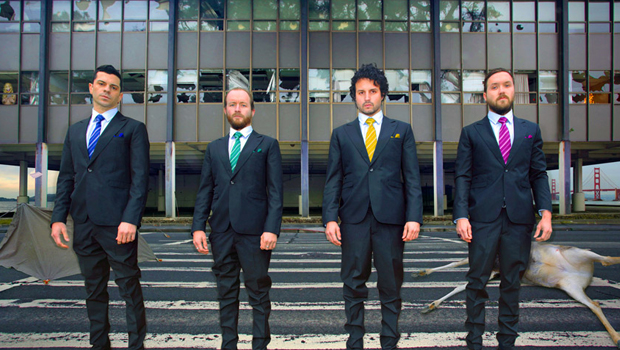
Once heralded as the next Tool, dredg have never been a band about following in footsteps. Funk, alt metal, pop rock -- the band seem to redefine themselves with each new release.
Their latest album, Chuckles and Mr. Squeezy, is no exception.
Awash with synths, keyboards and guitar effects that would make Tom Morello proud, Chuckles and Mr. Squeezy throws yet another curveball to fans.
Upon first listen, the album will almost certainly veer to the far left of your expectations, whatever those might be.
GuitarWorld.com recently got the chance to talk with dredg guitarist Mark Engles about Telecasters, working with Dan the Automator and most importantly -- what's up with "Chuckles" and "Mr. Squeezy"?
GUITAR WORLD: So let's get the most glaring question out of the way first. The album title, Chuckles And Mr. Squeezy -- where did that come from?
MARK ENGLES: We were on our way to dinner, on a break from the studio, and our engineer Tim Carter was joking around his fictional rodeo clown duo. He said he either wanted to me a musician or a rodeo clown, and his rodeo clown duo was Chuckles and Mr. Squeezy. So we all had a good laugh, and it kind of stuck and became this inside joke.
Get The Pick Newsletter
All the latest guitar news, interviews, lessons, reviews, deals and more, direct to your inbox!
As we started brainstorming album titles, it just really stuck out. We had this list of album titles, and this whole album is so different in every way -- art, music -- why not make the title stand out as well and not be caught up in what we’ve done in the past?
Well, whether fans love it or hate it, they’re definitely not going to forget it.
Exactly! [laughs]
So this album was produced by Dan the Automator, who is most known for working with acts like Gorillaz, Deltron 3030 and Handsome Boy Modeling School, among others. What did he bring to the table as a hip-hop producer that you wouldn't have necessarily gotten from a rock producer?
The first thing you hear right away is that keyboards kind of take over for the guitars, which is why for some fans, the first listen might be tough because keyboards kind of switch spots with guitars.
A lot of the keyboard parts I wrote on guitar, and then we transposed them for keyboards, so the guitars were still there -- just as a different instrument [laughs].
And then, of course, the drums. All the tracks have live drums and then Dan would go and mimic the beat with his style of drum programming and then mix the two.
I liken this album to [Radiohead's] Kid A, with the addition of drum machines and keyboards replacing guitars, and also kind of a more collaborative feel. Would you agree with that?
Yeah, for sure. I mean this was the first record I wasn’t there for every step of the way with my guitar production.
I will admit I would not like that every time, but it was refreshing for this one record. With Dan it was up to him sometimes to come up with something to make me react and play something -- something that didn’t exist yet. Whereas every previous record, I was very involved every step of the way with my guitar tones, the mix and everything.
It was cathartic. The drums are there, the guitars are there, let the producer do his thing.
It was good for us, with the long career we’ve had, to do something different. That’s not to say the next record won’t be the complete opposite [laughs].
What sort of guitars were you using on the album?
Mainly my ’68 Tele. I love Fender Telecasters. I also borrowed a couple of guitars from Tim Carter, our engineer. There were couple of Strats involved. Nothing too crazy.
How about amps?
A lot of the album was actually written in my bedroom using Logic, and after spending a couple of hours getting the tone down, a lot of those sounds ended up on the record.
Besides that, Dan had all these great little combo amps with like 3- or 2-inch speakers, with all these strange tones, very mid-rangey. And, of course, a Fender Twin and a Vox; they make appearances as well.
Was your approach to effects mainly analog or digital?
Both, really. I used an analog delay, but Dan had these oil can delay pedals. I think Morley makes them. It has this rotating cylinder that gives you a delay sound with a wah.
I used a couple of Echoplexes as well. I love the sound from using tape delays, the little flaws you get.
So this record features a pretty left-field choice for producer in Dan the Automator. Are there any other producers you’d like to work with in the future?
[laughs] There are always producers out there that you admire for different reasons -- whether it’s someone like Nigel Godrich who creates soundscapes that are unbelievable or, the opposite, someone like Cee Lo Green who can capture energy and create in a cool way with live-sounding drums.
I think the dream is to have four or five producers on one album. Maybe one track has a Steve Albini kind of sound and the next one is very pretty and has that Nigel Godrich Sound. That’s kind of the fantasy [laughs].
But the next record -- we’ll probably change it up again.
- GW
The new album from dredg, Chuckles and Mr. Squeezy, is out now
Photo credit: Merkley???
Josh Hart is a former web producer and staff writer for Guitar World and Guitar Aficionado magazines (2010–2012). He has since pursued writing fiction under various pseudonyms while exploring the technical underpinnings of journalism, now serving as a senior software engineer for The Seattle Times.



![[from left] George Harrison with his Gretsch Country Gentleman, Norman Harris of Norman's Rare Guitars holds a gold-top Les Paul, John Fogerty with his legendary 1969 Rickenbacker](https://cdn.mos.cms.futurecdn.net/TuH3nuhn9etqjdn5sy4ntW.jpg)







